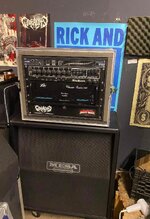OK, spent more time with this tonight. First I connected it to the app and updated the firmware. I also changed it to true bypass. This helped with keeping it in a parallel loop bypassed. They come with the DSP bypass on for tails.
In the loop of my Recto, turning down the direct and keeping delay at 99, I was able to get some better tones. I found a way to at least make it usable without comb filtering. I was able to get a better mix by messing with the mix on the back of the amp, that I usually never change. I did get it to work properly in the parallel loop, but still had issues getting enough volume out of it when compared to bypass. The bypass was always louder.
Next I put it in a parallel mixer pedal after the amp (after loadbox, before being reamped). This worked better because I could control the level of the parallel loop. I still messed with it for awhile, but was able to balance it better. I could probably get it better if I were going to keep it like that permanently and really dial it in. I kind of want to try to wire it into my big rack with the Samson SM-10, but I didn't feel like messing with it, lol.
I think as long as you keep it in a parallel mixer where you can control the volume of the loop, you would be OK with using the 2290p in parallel by using the direct at 0 and delay at 99, which is basically killdry mode. You also need to put it in true bypass mode in the app.
I want to try the same thing with my SDE-3000D here in a few weeks to verify that it is indeed analog dry though.
All of this was basically about the connections and verifying if the 2290p is analog dry through. I really didn't talk about the tone. I definitely think it sounds great. It is very musical, and the chorus, flanger, and delay tones all sound great. I do think running it in series is very transparent. I am very sensitive to digitizing messing with the tone and dynamics, and this is one of the most transparent I have experienced. I think it sounds great, but it is definitely not analog dry through.

